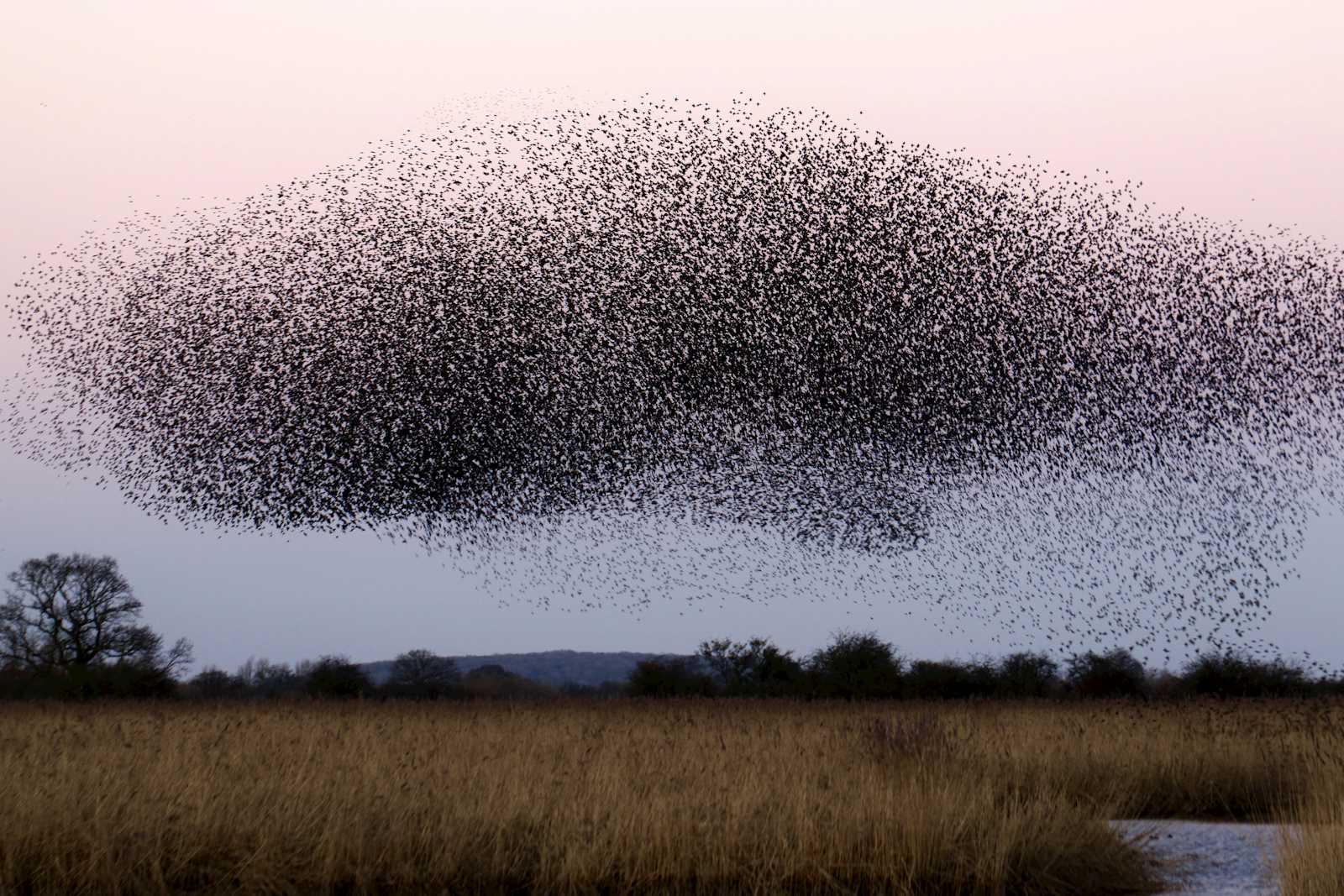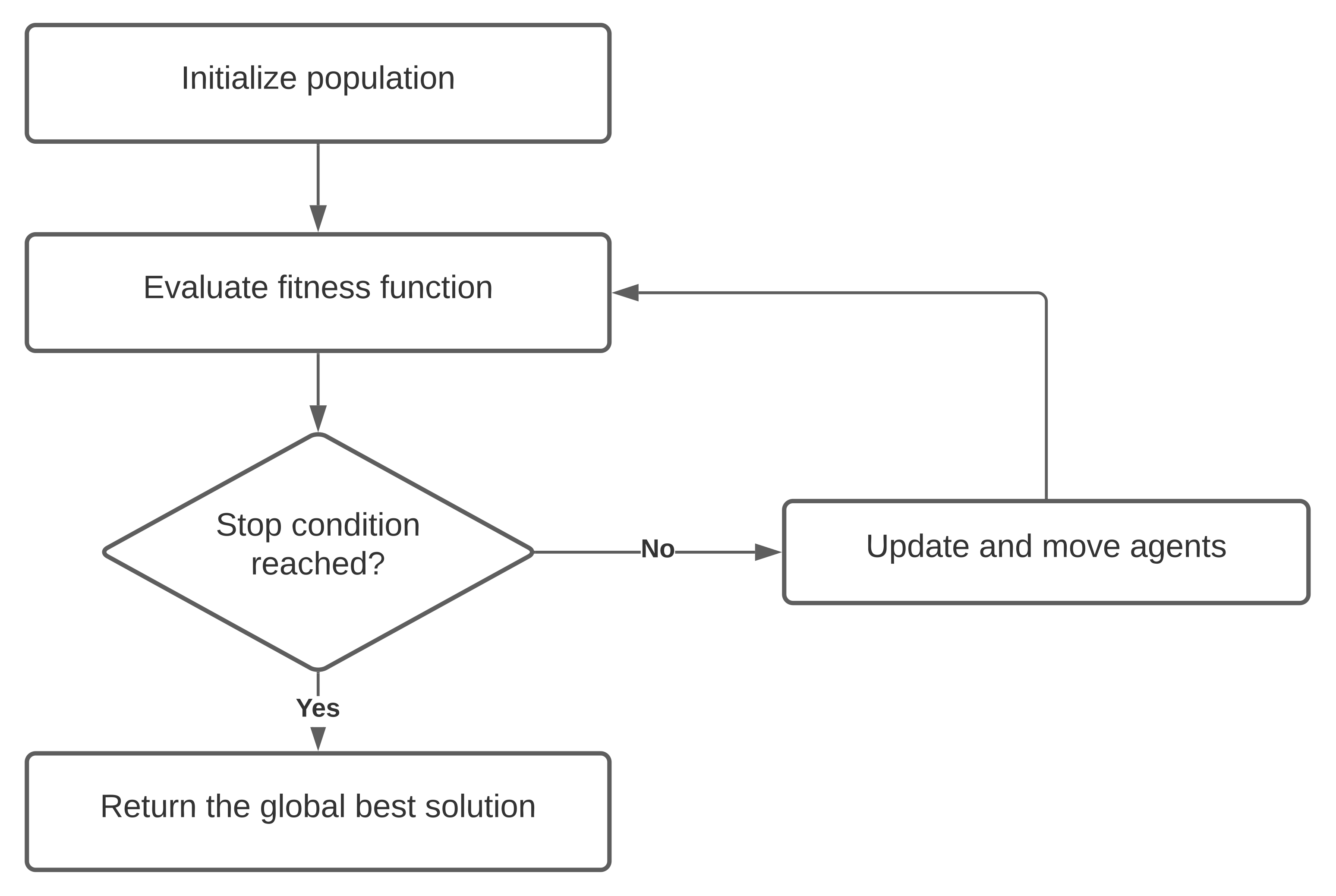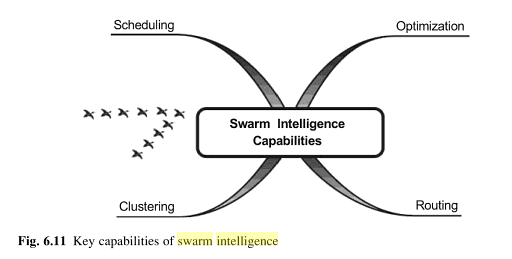Swarm Intelligence Series: Introduction
 Akash Gss
Akash GssTable of contents
- So, why do we need MetaHeuristic algorithms?
- Biological Meta-Heuristic Algorithms
- Expanding Upon Swarm Intelligence Algorithms
- Principles of the Swarm Behaviour
- General Steps of Swarm Intelligence
- How exactly has Nature Helped to Form these Algorithms?
- Types of Swarm Intelligence Algorithms that will be covered
- Applications of these algorithms and future directions summarized
- Conclusion

MetaHeuristic algorithms are a kind of algorithm that are used to find good enough or approximate solutions to a wide range of problems that are in general very hard or expensive or slow to find using the traditional deterministic algorithms that tend to provide only a predictable type of result based on the input you provide. Meta-heuristic algorithms are more probabilistic and are pretty much non-deterministic in general unlike traditional algorithms and are used to solve problems that can be solved iteratively or in steps.
So, why do we need MetaHeuristic algorithms?
MetaHeuristic algorithms at their core are probabilistic algorithms with no definite result and they are employed to solve optimization problems where deterministic algorithms tend to fail in general. These algorithms work by trying to solve a problem in a step-by-step manner, starting from an initial or a root solution value and performing a randomized search across the given problem set or search space to find a better or optimal solution than the root solution and iterate from there until they finally reach an optimal solution at the end. These algorithms are employed to solve problems that are NP-Hard in nature aka algorithms that are very difficult to solve in the traditional deterministic manner. However, by employing these meta-heuristic algorithms, we can often find very good solutions to these abstract and complex problems in a reasonable amount of time.
Meta Heuristic algorithms are in general used to solve optimization problems and are often used when traditional methods such as linear programming are not suited to solving the problem at hand and are in general utilised when the traditional way of solving these problems fails.
Biological Meta-Heuristic Algorithms
Now, we will be diving right into what a "Biological" Meta-Heuristic Algorithm exactly means. A Biological Meta-Heuristic algorithm is an algorithm that has been heavily inspired by the behaviors and patterns that have been exhibited by species in wildlife like wolves, ants, and so on.
These algorithms have been modeled around how these species hunt and perform a lot more tasks in their daily life and their evolution cycle as a whole. This field of research has been gaining significant popularity over the years among researchers due to its inherent nature of inspiration being fauna found in nature. These algorithms have been classified and inspired by various ecosystems of animals like ants, termites, fishes, birds, and more and the core characteristics of these algorithms tend to mimic the behaviors and patterns observed from these wildlife species in nature at different levels.
These algorithms have been proven to be used mainly to solve NP-hard problems in an approximate and deterministic way. The scope of this article series will be limited only to a sub-class of the meta-heuristic algorithms known as the Swarm Intelligence Algorithms which constitute a significant part of this sub-class in machine learning and include algorithms like Ant Colony Optimization, Artificial Bee Colony Algorithm, Firefly Algorithm and more.
Expanding Upon Swarm Intelligence Algorithms
Now, we will be diving deep and expanding upon the main preface of this article and the article series - "Swarm Intelligence Algorithms".
The Swarm Intelligence algorithm represents a class of machine learning algorithms known as biological meta-heuristic algorithms aka algorithms that have been employed to solve abstract problems in the real world that cannot be solved using the traditional deterministic algorithms by observing and identifying patterns exhibited in nature. The goal of this subset of the algorithm is to develop systems that can learn and adapt over time [like how a neural network does] often without needing any deliberate programming from the creator's end and can self-learn on its own through the process of pattern analysis within specific constraints that have been determined depending on which natural phenomenon it has been modeled or inspired from.
Principles of the Swarm Behaviour
The principles of this algorithm are based on the behavior of a "swarm" in nature that in general involves heavy amounts of collaboration, cooperation, communication, and self-organization.
These principles have been identified by the behaviors exhibited in nature especially animals like ants, wolves, and more, and are based on their behaviors of hunting food, cooperating to find safety, moving around in the form of swarms or herds, and their collective ability to learn from each other through the process of mimicking behaviors and more. These principles have been utilized to create and define machine learning algorithms that similarly can find the optimal solution to a specific non-deterministic problem through the process of exploration and exploitation and more.
General Steps of Swarm Intelligence

In general, swarm intelligence optimization algorithms start with the generation of random solutions. The steps taken in general are -
Initialization of the sample set or population: For a given optimization problem, a random set of solutions gets generated and is iteratively updated in case they violate any of the constraints.
The evaluation is performed on all of the initialized individual solutions
After this, while the algorithm is not terminated we do the following
Reproduce individuals to form a new population
Evaluate the fitness of each solution
Solutions with better fitness values are selected
The solutions are updated whenever a maximum or minimum as per the problem definition is achieved.
How exactly has Nature Helped to Form these Algorithms?
Now, a lot of you guys will have questions arise about how exactly this collective sense of community in nature applies to machine learning algorithms to solve complex mathematical / computer science-based problems and now, we will be breaking this down.
The practical real-life application of this behavior can be understood through the following
Exploration and Exploitation: Almost all swarm intelligence algorithms, have been inspired by the ability of animals to flock and group themselves. Animals in a group tend to in general exhibit a balance between exploring new areas in the wide spreads of fauna on this planet and exploiting the areas that they have identified as being fruitful for them. Similarly, in practical ML Implementations, the individuals or agents in a specific machine learning algorithm tend to collaborate and communicate to expand upon the given vast search space to find satisfactory optimal solutions to the problem at hand and iterate on it.
Communication and Knowledge Sharing: The wildlife in a group like a group of ants and more tend to communicate and share information and are very collaborative. For example in the case of an ant colony, once an individual ant finds food, it tends to emit pheromones which is like a signal calling other ants to the food source it has found. And, in wildlife, there is also an exchange performed to evaluate and communicate information that they have found. Similarly, in the case of a practical machine learning algorithm, the individuals or agents that are a part of it, tend to exchange the quality of the steps that is being taken and they tend to come to a collective consensus to find if they are taking the right step ahead.
Emergent Behaviour: This flocking of animals together tends to form some extremely complex patterns and solutions which are in general not noticed when only an individual animal is considered. Similarly, in the case of ML algorithms working on Swarm Intelligence, the collective interactions and dynamics of the individual agents lead to the emergence of solutions that can outperform and beat individual search strategies.
Global and Local Search: The grouping behavior is used to perform both global and local searches to find the most optimum solution possible for the problem in focus. Animals in a group can cover very large amounts of area [global search] while also focusing on the individual local areas [local search] that tend to be very promising for them. Similarly, ML algorithms employing this use the grouping strategy from wildlife to ensure that the search process used to solve the problem at hand explores a wide area while not ignoring the local maxima areas and expanding their search in fruitful local areas that display a maxima and a higher probability of solving the problem considered in a much faster way.
Types of Swarm Intelligence Algorithms that will be covered
In this series of articles, we will be covering over 10 swarm intelligence algorithms and these are some of the most popular ones. These algorithms use various aspects of wildlife and have modeled algorithms based on the patterns and behaviors exhibited in the wild by different animals/species of fauna. All of these algorithms are popular because of their ability to handle complex optimization problems and searches in a big enough search space that is abstract or for the exploration of a large enough parameter space such as hyperparameter tuning in ML.
Particle Swarm Optimization: The Particle Swarm Optimization Algorithm is an optimization technique that is stochastic and is inspired by the social behavior of birds and fish moving together or flocking together in groups [known as schools in the case of fishes] and it is widely used for solving abstract problems in a wide enough search space.
Chicken Swarm Optimization Algorithm: This algorithm is based on the hunting or foraging process undertaken by chickens and the core concept of this algorithm is to construct a random search method through the process of simulating the behavior of roosters, hens, and chickens when they flock together or move together in groups.
Ant Colony Optimization: This is inspired by the food gathering and hunting taken up by ants in an ant colony and the process they undertake for cooperation and transporting the food from Point X back to their colonies. It is a very popular technique used in machine learning to solve for a common objective.
Artificial Bee Colony Optimization: This algorithm mimics the nectar-gathering process of bees and identifies the sources of food for them. It has been used to solve numerical problems and mainly for time series forecasting problems.
Grey Wolf Optimization Algorithm: This algorithm is inspired by the hierarchy noticed in most wolf packs and their patterns of hunting and it is used heavily in machine learning for function optimization and fine-tuning.
FireFly Algorithm: This algorithm is inspired by the specific flashing patterns that are noticed in fireflies and it is used for solving a lot of optimization problems for the global maxima or minima in ML.
Krill Herd Optimization: This algorithm is inspired by the hunting patterns of krill and is used for solving common optimization problems in ML.
Moth Flame Optimization: This algorithm is inspired by the behavior of moths seeking a flame or a light source in general and is used for solving global optimization problems in machine learning.
Bacterial Foraging Optimization: This algorithm mimics the bacterial foraging behavior and is used in machine learning for optimization problems that have very complex constraints involved like the fuzzy goal programming for inventory management problems and more.
Cuckoo Search Optimization Algorithm: This algorithm is inspired by the brood parasitism behavior of cuckoos and is used in machine learning for optimization problems, particularly in the field of bio-inspired optimization of ML.
Applications of these algorithms and future directions summarized
Swarm Intelligence and Biological Meta-Heuristic problems in general are used mainly to solve optimization problems and problems that are NP-Hard or have a large enough search space that cannot be traversed or parsed through the traditional methods of deterministic algorithms. We will now be discussing how these wide arrays of algorithms help us to solve some critical problems in the ML field -
Data Science: Swarm Intelligence algorithms are utilized to solve complex optimization problems in data science like the organization of data, reducing dimensionality facilitating the moving of the data points into lower-dimensional feature spaces, and more.
Internet of Things: Swarm Intelligence algorithms are used in IoT for optimization tasks like increasing the life of the network, optimizing the process of finding the cluster head in a sophisticated network of devices, and more.
Image Processing: Swarm Intelligence optimization algorithms are used extensively for image processing for tasks like segmentation, classification, feature extraction, and edge detection in images.
Famine Forecasting: The Food and Architecture Organization [FAO] uses swarm intelligence algorithms to forecast and predict famines that could occur in famine-vulnerable regions.
Military and Space Exploration: Swarm Intelligence Techniques are utilized by the US Military for controlling unmanned vehicles. The European Space Agency also uses them for the self-assembly and interferometry of orbital swarms.
Robotics: Swarm Robotics is a hot and upcoming field that involves the coordination of large groups of simple robots to perform complex tasks. Swarm algorithms are used to control robot swarms for tasks like exploration, surveillance, search and rescue operations, and environmental monitoring.
Traffic Management: Swarm intelligence is heavily utilized for the reduction of congestion in traffic flow, optimizations, and increasing overall transportation efficiency. These algorithms help in dynamic route planning, signal control optimization, and adaptive traffic light coordination.
Wireless Sensor Networks: In Wireless Sensor Networks, swarm intelligence algorithms are used for tasks like energy-efficient routing, data aggregation, and localization, and increasing the overall coverage of a network and its lifetime.
Supply Chain Management: Swarm Intelligence algorithms act like a perfect fit for solving problems and identifying areas of optimization in the supply chain. It is heavily utilized for the optimization of inventory levels, distribution routes, warehouse operations demand forecasting, and more in the supply chain space.
Medical Imaging: Swarm Intelligence algorithms are utilized for medical imaging tasks like image reconstruction, feature selection, disease diagnosis, and treatment planning. These algorithms aid in improving the accuracy and efficiency of medical image analysis processes.
Conclusion
Finally, we have reached the end of the first introduction article that will kick off a series of swarm intelligence algorithms which will be explained in detail. Biological meta-heuristic optimization algorithms are an emerging field of solving complex optimization problems in the real world in multiple areas. These algorithms are mainly inspired by the natural behaviors of living organisms and they mimic the collective intelligence and adaptive behaviors observed in nature. From swarm algorithms to biological heuristic algorithms based on animals, these approaches offer efficient and effective solutions to a wide range of optimization challenges and these algorithms tend to solve problems in a large number of areas starting from data science to supply chain management.
The research in this field is still ongoing with new algorithms based on animal patterns still being discovered. We will continue to see more advancements in this area with innovative and effective ways of tackling more NP-hard problems or complex optimization problems.
Overall, biological optimization algorithms represent a fascinating and promising area of research that has the potential to revolutionize the way we approach optimization problems in the future.
Subscribe to my newsletter
Read articles from Akash Gss directly inside your inbox. Subscribe to the newsletter, and don't miss out.
Written by


